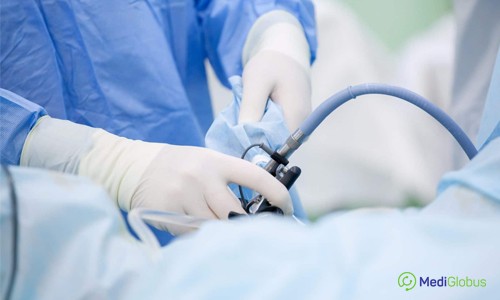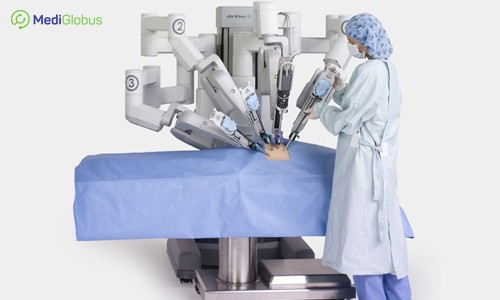Prostate adenoma is a pathological proliferation of prostate tissue that squeezes the urethra and leads to dysfunction of urination. Often the neglected forms of the disease cannot be eliminated in a conservative way. Surgical intervention is the only method for solving this problem.
Treatment of prostate adenoma abroad by surgical intervention gives positive result in 98% of cases.
READ IN ARTICLE:
When is surgery required to remove prostate adenoma?
Options for the surgical treatment of prostate adenoma
Surgical treatment of prostate adenoma in the top foreign clinics
WHEN DO I NEED SURGERY FOR BENIGN PROSTATE HYPERPLASIA?
The main indications for surgical treatment of prostate adenoma are:
- Lack of effectiveness of drug therapy and, as a consequence, the deterioration of the patient;
- Complete retention of urine flow;
- Pain while urinating, and blood in urine;
- Appearance of renal failure symptoms;
- Progression of the inflammatory process in the urogenital system;
- Deposition of stones in the bladder;
- Increased red blood cell levels in the patient’s urine;
- Complication of prostate adenoma with urinary tract infections.
OPTIONS FOR THE SURGICAL TREATMENT OF PROSTATIC ADENOMA
In foreign clinics and medical centers, various surgical methods are used to treat prostate adenoma. Preference is given to minimally invasive operations. These are less painful and non-traumatic. The full recovery period after these operations is minimal. These include:
- Transurethral resection (TUR);
- Transurethral incision (TUI);
- Laser or plasma vaporization;
- Laparoscopy;
- Embolization of prostate artery.
Transurethral resection of prostate (TURP) is a procedure that is used to remove prostate neoplasms weighing up to 60 g. It is important that such an operation should not be done on patients suffering from renal failure.
This type of operation is carried out using a resectoscope, which is equipped with a special camera, lighting and an electric loop with a water supply system. The endoscope is gently inserted into the urethra and guided into the neoplasm, where excision of adenoma into fragments is performed. Removed tumor particles are flushed through the urethra. The trauma of TUR is minimal. 97% of patients going through such an operation are positive. The duration of hospitalization is from 1 to 3 days, and the period of full recovery does not exceed 2 weeks.
Transurethral incision (TUI) is a surgical intervention that is performed using a special endoscope inserted into the urethra. It involves the dissection of the affected prostate tissue adjacent to the urea. This operation is needed to increase the lumen of the urethra and the resumption of urine outflow, and not to remove the hyperplasia itself. In this case, prostate incisions are made with a laser or high-frequency current. The effectiveness of this operation is less than TURP, but also the risks too. The recovery period is 10 days.

Laser vaporization is a procedure that allows you to remove prostate adenoma by evaporation with powerful laser radiation. It does not require external cuts and can be carried out at any size of the tumor. Injury of healthy tissue is absent. The evaporated fragments of the prostate neoplasm are excreted through the urethra. Anesthesia is not required. Laser vaporization is a worthy alternative to TURP. It is important that the duration of the surgical intervention itself does not exceed 1 hour. The recovery period of the body is about 7 days.
Plasma vaporization is an operation that is performed endoscopically and is characterized by minimal blood loss. According to the European Association of Urology, this procedure is the most effective and safe among all types of surgical treatment of prostate adenoma. It is carried out with the help of cold plasma, which vaporizes the tissues of the adenoma.
Plasma vaporization can be made to patients suffering from cardiovascular diseases, because an electric current is not passed through the body of the patient. A special saline solution is used to remove residual tumors. After this procedure, there are no hemorrhagic complications, and the recovery period of onanism does not exceed 7 days.
Laparoscopy is an operation that is performed through small punctures on the skin of the lower part of the abdominal cavity. Laparoscopic instruments and trocars (tubes that provide clearance for insertion of instruments) are used to remove the adenoma. The operation itself is visualized on the computer. Therefore, doctors can accurately perform all actions without subsequent complications. Operating time does not exceed 145 minutes. General anesthesia is used for pain relief. The main contraindications for this type of surgery are:
- Presence of an inguinal hernia in a patient;
- Saccular bulging of the bladder walls;
- Urolithiasis disease;
- Abnormal stiffness of the joints of the lower extremities (ankylosis).

After laparoscopic removal of prostate adenoma BPH, the patient stays in the clinic for several days. Recovery period is about two weeks.
Embolization of the prostate artery involves stopping the blood supply to the prostate gland through vascular occlusion. This procedure is performed surgically. The termination of the “power” of the prostate causes its reduction. Thus, the lumen of the urethra and urinary function are restored.
In extreme cases abroad, method of removing prostate gland adenoma, such as trans-vesicular adenomectomy, is used. It is among the open surgical interventions and is carried out with a significant increase in adenoma (more than 80 g). Adenomectomy is quite traumatic surgery. It provides the complete removal of the prostate through the urethra. Recovery period of the person after adenomectomy is about two months.
Main complications of this operation include:
- Impaired intestinal motility, fecal stagnation;
- Bleeding from the place of adenoma;
- Congestive pneumonia.
In foreign medical centers, Da Vinci robotic system is used to remove prostate adenoma. With the help of this device, the low-traumatic operation of the prostate gland is carried out. There is no damage to surrounding tissues, and the recovery time of the body is significantly reduced. It is important that this installation is practically not used in the developed countries. There are no qualified specialists who have experience with this system.
SURGICAL TREATMENT OF PROSTATE ADENOMAS IN THE TOP FOREIGN CLINICS
Thousands of foreign patients annually apply to foreign clinics for the operative treatment of prostate adenoma. Leading medical institutions that deal with surgical removal of this pathology abroad are:
- Assuta Medical Center (Tel Aviv Israel);
- Apollo Medical Group (India);
- Navarra University Hospital (Spain, Pamplona);
- Sourasky Medical Center (Ichilov) (Israel, Tel Aviv);
- Medistate Hospital (Turkey, Istanbul);
- Anadolu Medical Center (Turkey, Gebze, Istanbul);
- Motol University Hospital (Czech Republic, Prague).
To avoid mistakes in choosing a foreign clinic for the surgical treatment of prostate adenoma, you need to use the services of the international medical platform MediGlobus. Specialists of our company will establish your connection with a foreign medical institution, clarify all the details of treatment, arrange a comfortable trip and arrange an interpreter at a foreign clinic.





